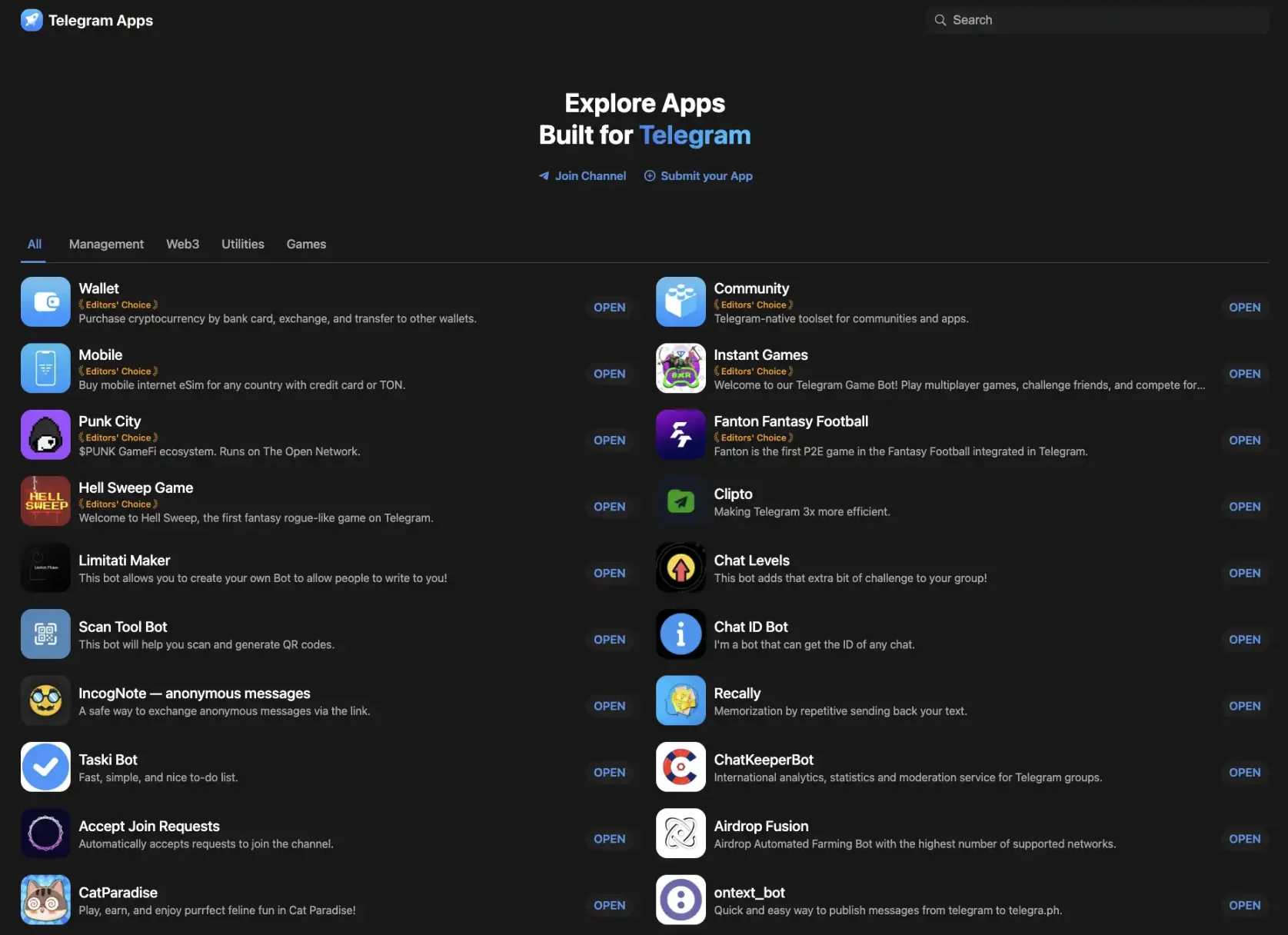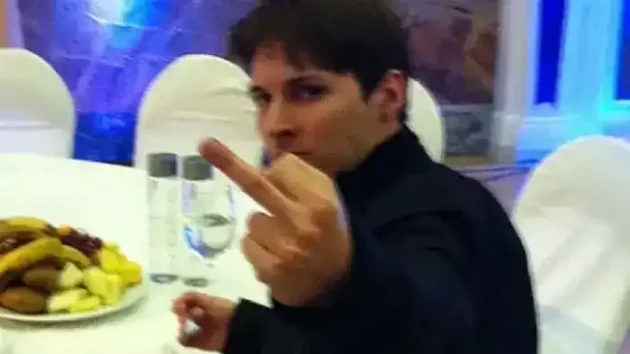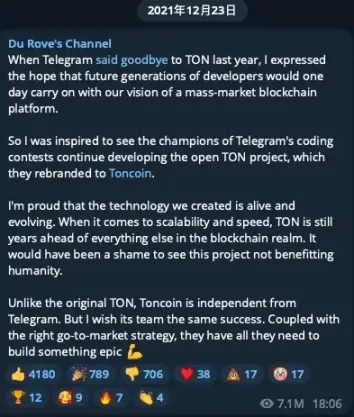Author: 0x26
In August 2023, the instant messaging protocol Telegram celebrated its 10th anniversary. In addition to celebrating its monthly active users exceeding 800 million, Telegram also highlighted the Story feature on its anniversary. This feature allows users to share dynamic videos and pictures with their contacts, similar to the feature on Instagram, a social platform owned by Meta.
All signs indicate that Telegram, which started with independence, security, and privacy, seems to be breaking free from gravitational pull and flying higher.
- Grayscale releases ‘good news’, can it break the Bitcoin September curse?
- Uniswap wins collective investor lawsuit, becoming a precedent sample in the face of DeFi regulatory challenges
- Financial Times How do industry insiders view Grayscale’s victory? How much impact will it have on the future regulation by the US SEC?
One day in 2012, Telegram founder LianGuaivel Durov and employees from his former company VK stood in front of the window of their office in the busiest area of St. Petersburg, throwing paper airplanes made of banknotes at passersby.
For users familiar with encryption, the prevalent bot services on Telegram are gaining popularity. The most well-known and highest-valued project among them is Unibot. With a market capitalization of over $150 million in less than six months since its listing, this bot product has conquered many cryptocurrency users with the expectation of a broad user base on Telegram and its simplicity and convenience.
Its supporters often say that “Unibot is a hundred times better than the largest wallet application in the current market, Metamask, or with Telegram’s 800 million users, Unibot’s mass adoption will surpass Metamask and the like.”
Why do so many people have high hopes for Telegram products? The reason is simple: Telegram, with its extensive user base and openness, is an untapped territory.
As founder and CEO LianGuaivel Durov wrote in his 10th-anniversary message,
“In just 10 years, Telegram has gained over 800 million active users through word of mouth.
…
Telegram’s next step is to go beyond messaging and lead the innovation of social media. We should use our popularity to improve the lives of billions of people and inspire and uplift people on Earth.”
Although the past 10 years have been exciting, the next 10 years will be the time for Telegram to unleash its true potential.”
Super App
In recent years, Telegram’s efforts to transition from a communication protocol to a broader social platform have not stopped. With the introduction of paid Premium subscriptions in June 2022, Telegram’s product updates have rapidly accelerated.
Since 2022, the speed of Telegram's product updates has noticeably increased, with a focus on social aspects.
Not only did Telegram recently launch the Story video sharing feature, which rivals Instagram, but in June 2022, it also introduced Premium subscription services. After providing value-added services to Premium users, Telegram has also revamped its sticker system, launched blockchain-driven anonymous number login functionality, and introduced the Topic feature, directly competing with Discord’s multi-group management feature.
It seems that both Instagram and Discord, excellent social media platforms at home and abroad, have features that Telegram covers. Not only that, Telegram is learning from WeChat and trying to complete a three-level leap from communication protocol to social platform, ultimately becoming a super app based on its extensive user base.
Thanks to the open-source nature of the Telegram client, various rich SDKs, and the comprehensive Bot API provided by the official for developers, countless developers can create their own service robots and freely compete with the official application. Users can easily find various service functions such as music, movies, books, and games on Telegram.
The TON Foundation, closely related to Telegram, also launched the Telegram Apps application center in August this year, integrating various applications from Telegram, including games, wallets, and utility tools.
Telegram’s “Dark History”
Telegram and cryptocurrencies seem extremely similar in some aspects. They were not well regarded in the early stages and were often used for illegal purposes. They aimed to transform and target open and transparent large-scale application scenarios. Not only that, Telegram once chose to issue coins. During the ICO boom in 2017, Telegram planned to develop the next-generation blockchain platform, TON (Telegram Open Network), and intended to name its cryptocurrency Gram. However, the good times didn’t last, and the TON, which raised more than $1.7 billion, was halted due to US regulatory intervention.
Telegram chose to issue coins instead of going public like social giants Meta and Tencent for a reason: founder LianGuaivel Durov insisted on freedom of speech and privacy protection, which can be seen from his early experiences.
LianGuaivel Durov, who has shown remarkable programming talent at a young age, and his genius brother Nikolai Durov, who has won gold medals in multiple math and information Olympiads, founded VKontakte (VK), the most popular social networking site in the Russian-speaking region. Although VK borrowed from Facebook, it was the only product that surpassed Facebook in free market competition.
With the expansion of VK’s influence and the intensification of factional struggles in Russia at that time, the Russian government requested that VK close social pages of the opposition for the sake of stable public opinion. In response, LianGuaivel firmly refused.
In order to uphold freedom of speech, LianGuaivel had no choice but to flee Russia. Even so, eventually LianGuaivel was forced to give up VK—by selling VK’s shares, and the ownership of VK was eventually resold to companies closely related to the Russian government. It is rumored that LianGuaivel obtained hundreds of millions of dollars in the transaction of selling shares.
LianGuaivel Durov's response to the attempt by the consortium to acquire VK
Telegram’s inspiration comes from LianGuaivel’s experience of battling with the Russian government during his time at VK. In an emergency, LianGuaivel suddenly discovered that all of his communication methods, including phone calls and emails, could be monitored by the government.
Telegram’s successful technical foundation comes from the underlying encryption protocol MTProto developed by LianGuaivel’s brother Nikolai and a group of top-notch geeks. At the same time, LianGuaivel’s competition with Mark Zuckerberg shifted from social media to communication protocols, as Facebook acquired WhatsApp in February 2014. Today, Telegram and WhatsApp often have disputes over privacy issues.
Even though the plan to issue tokens to provide operational funds was halted by the US government, Telegram has never forced users to pay. In the early days, Telegram’s operating funds mainly came from the personal wealth of the LianGuaivel brothers. As the user base continued to grow and product features upgraded, Telegram’s operating costs skyrocketed, and eventually LianGuaivel chose to finance Telegram through bonds.
Telegram has received external funding twice since 2021. The first time was in March 2021 when LianGuaivel announced that over $1 billion was raised through the sale of bonds. The second time was in July 2023 when LianGuaivel announced that in order to maintain operations, Telegram issued $270 million worth of bonds, of which LianGuaivel personally purchased 25%. In this letter, LianGuaivel also revealed two important pieces of information: Telegram adds 2.5 million new users daily, and LianGuaivel himself does not own luxury items such as real estate and private jets, only “owns” Telegram, some bitcoins, and Toncoin.
Telegram’s Map of Encryption
Following in the footsteps of Meta and WeChat to create social media and more open super apps can only be considered a visible strategy, while introducing and promoting encryption is the hidden move.
Visible Strategy, Hidden Move
Although Telegram’s official blockchain platform Ton Network declared its end in 2020, at the end of 2021, LianGuaivel Durov suddenly posted on his personal Telegram channel, saying,
“I see that the champions of the Telegram coding competition continue to develop the open-source TON project and rebrand it as Toncoin. This is very encouraging.
……
Toncoin is different from the original TON and is independent of Telegram. But I hope their team can achieve the same success.”
Note, Toncoin stands for The Open Network, the token of TON.
This statement was one of the efforts endorsed by Telegram as part of the TON project, and this speech received more than 7 million views, far exceeding the daily data of the LianGuaivel channel.
Subsequently, TON was always closely associated with Telegram in an unofficial but seemingly official manner.
In 2022, Telegram launched a domain name system based on the Ton Network and planned to auction Telegram usernames in the form of NFTs, settling with TON tokens. In the process of promoting the decentralized domain name system, the freedom-loving Telegram even resorted to centralized and mandatory measures.
According to information from Twitter and V2EX users, Telegram has unexpectedly reclaimed long-unused accounts and some premium usernames used in announcement channels. A user whose username was reclaimed once said, “No one is willing to pay about $160 for a Telegram username.” But he clearly underestimated the enthusiasm of the cryptocurrency industry, as several usernames have been sold for over $2 million.
Data source: statista, unit: $1000
In October of the same year, LianGuaivel announced that he personally participated and, together with four other people, completed the construction of the decentralized auction platform Fragment based on TON in just five weeks. Not only usernames, but also Telegram’s anonymous numbers and Premium features were launched on the Fragment platform, which supports TON token payments.
The non-custodial wallet Wallet (TON SLianGuaice) built into Telegram was launched in August 2023 and currently supports USDT, BTC, and TON.
As the expected financial settlement method of Telegram, the built-in non-custodial wallet not only guarantees security, but also eliminates the hidden risk points of introducing third-party payment settlement platforms for Telegram. It also unlocks the financial attributes of the Telegram platform itself, delivering financial security and freedom to more users, and allowing Telegram’s functionality, composability, and user stickiness to grow exponentially.
The Open Network
As for the closeness of the relationship between Telegram and TON, perhaps only LianGuaivel and his inner circle can fully clarify.
According to drawesomedoge, a member of the former TON core development team, we can summarize some details of the development process of TON and TON tokens.
New Ton, formerly known as TON, had 13 members from Slavic-speaking countries such as Russia and Ukraine in its core development team, and continued to maintain and develop after the official announcement of TON’s discontinuation. It gained recognition from LianGuaivel at the end of 2021. With the rise of New Ton, another branch named Free TON chose to leave and renamed itself Everscale, and also changed its programming language.
As for the allocation of TON tokens, it is even more mysterious. Generally speaking, TON tokens have already been distributed through Proof of Work (PoW) mining, and the information of the majority of token holders is basically unknown.
According to drawesomedoge, among the total supply of 5 billion TON tokens, around 100-200 million tokens were allocated to the earliest developers. The remaining tokens were divided into 4.7 billion and 100 million, and placed in two Proof of Work (PoW) smart contracts for mining. The majority of the 4.7 billion TON tokens were mined in the two to three months in the second half of 2020.
Information from the TON official website indicates that “In order to avoid the team’s work stoppage from affecting the project’s development, and to allow enthusiasts to continue researching the technology, the Telegram team has placed all available tokens in the smart contract, and anyone can mine them fairly.”
Starting from June 2020, all the circulating Toncoin tokens (98.55% of the total supply) were open for mining. Subsequently, the miner’s code was published in the code repository, and tutorials on how to mine were also published on the project’s website. At that time, the blockchain was still in the testnet stage, and the tokens had no value and could only be used for testing purposes.
On June 28, 2022, the last Toncoin was mined, successfully completing the initial allocation of TON.”
Today, TON has transitioned to Proof of Stake (PoS) and is increasing at a rate of 0.6% per year, approximately 30 million TON per year.
The cloud of uncertainty surrounding the distribution of TON tokens hangs over the heads of all enthusiasts. As for who took the largest portion of TON, drawesomedoge believes it may be the early developers and enthusiasts, and he also mentions an interesting point that the TON Foundation holds more tokens than the core developers.
This brings us to the TON Foundation, which is responsible for all non-development work such as finance and marketing, and can be said to be one of the few entities exposed to the outside world in TON. According to drawesomedoge’s speculation, the founding members of the TON Foundation may be early investors in Telegram. According to LinkedIn data, many members of the TON Foundation are located in Dubai, which is also rumored to be the location of Telegram’s headquarters.
Among the founding members of the TON Foundation, we also discovered Andrew Rogozov, the former CEO of VK founded by LianGuaivel. Andre worked at VK for 7 years and stepped down as VK CEO in 2021, which is a crucial time for the launch and mining distribution of TON tokens. These aggregated information inevitably raises suspicions about whether all of this is a sleight of hand by LianGuaivel to bypass US regulations.
The Wild Growth of Cryptocurrency Services
Compared to Telegram’s “beloved child” TON, Telegram, as the most encryption-friendly platform, is more famous for its various encrypted communication groups, bots, and announcement platforms. A large number of real users migrated from Slack and WeChat groups have brought Telegram a large number of fresh and high-quality users, and have also given birth to various services such as news, CEX announcements, large-value transfer notifications, and daily push notifications. In short, Telegram has the two things that major Layer 1 platforms need the most – users and developers.
Innovation emerges from this open and vibrant soil.
Although Telegram’s core functionality is not developed for third-party developers, transactional bots that simplify user operations and interact directly with blockchain networks such as Ethereum through command instructions have become popular. They not only have a wider reach than TON but also have strong data support. On August 26, Unibot accounted for 2% of the total trading volume on Uniswap, which is considered the absolute leader in the DEX track. Through Unibot, the trading volume may surpass some famous VC-supported DEX platforms.
Not only is the trading volume high, but the revenue of such tool products is also considerable. According to statistics from Twitter user Sammi, the leading player in this field, Unibot, is expected to generate monthly revenue of over $6 million through token transaction taxes and transaction fees. MaestroBots relies entirely on subscription fees and transaction fees, with monthly project revenue exceeding $4 million.
This Telegram Bot trend has also led to the emergence of various types of Bot services in this field, including leverage contracts, sports event prediction markets, airdrops, and derivatives. The cryptocurrency data analysis website Coingecko has even added a Telegram Bots category, with over 100 projects included, with a total market capitalization of over $250 million.
It is even imaginable that in a few years, when figures like Musk “shill” the next generation of Dogecoin, users who are quick to react will not open wallets, launch DEX or CEX platforms, or undergo personal authentication. Instead, they will open Telegram, enter the token code and quantity in the pinned Bot window, and directly send instructions to Ethereum through the Bot protocol to complete the purchase.
Unlocking the phone and entering commands replace wallet password input and opening web pages, making the process smoother and faster.
With cryptocurrencies, every user can call various data and contracts anytime and anywhere through Bots. As for Telegram, which has built-in wallet functionality, industries such as e-commerce and food delivery may also integrate and migrate to Bots. We can perhaps look forward to a future where Telegram solves the majority of ordinary people’s daily needs.
Whether it is TON or Bot-like products based on Telegram, they are all important factors in stimulating market vitality and imagination and promoting mass adoption. As TON ecosystem enthusiast Jerry said, “A product with 800 million monthly active users doesn’t need a portrait; it has everything you want.”
With a massive and continuously growing user base, Telegram is leveraging encryption to target social interaction, opening up broader horizons for itself and the cryptocurrency industry.
Telegram has taken 10 years to show users what independent and secure communication protocols are, and what Telegram is doing and will do is something that heavyweight giants are probably unable to learn or understand.
Like what you're reading? Subscribe to our top stories.
We will continue to update Gambling Chain; if you have any questions or suggestions, please contact us!








